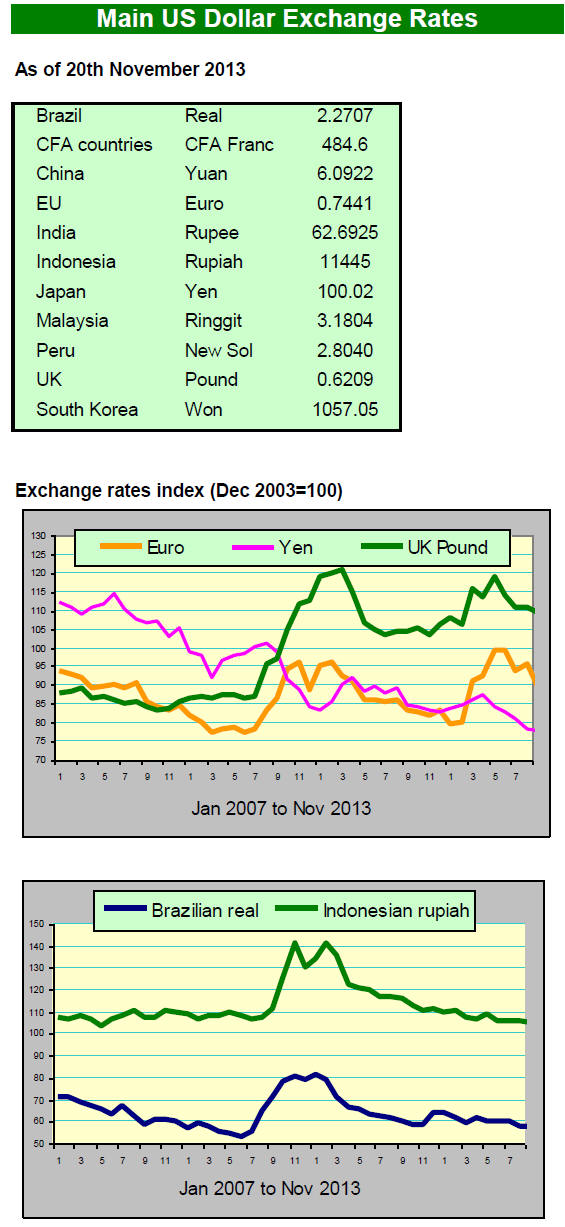2. GHANA
First three quarter export data released
According to data from the Timber Industry Development
Division (TIDD) of the Ghana Forestry Commission
(GFC), the country earned Euro 91.35 mil. from the export
of 206,603 cu.m of wood products in the first three
quarters of 2013 as against Euro 68.93 mil. from the
export of 179,819 cu.m in 2012.
Exports in the first three quarters of 2013 increased 32.5%
in value and 4.9% in volume compared to the same period
last year.
The European Union is the country‟s major market for
wood products and, for in the period reviewed, accounted
for Euro 39.45 mil. or almost 49% of all exports.
The United States imports of kiln dried sawnwood
amounted to 17% of the total volume of sawnwood
exports and were worth euro 5.48 mil. The main species
exported as sawnwood were wawa, mahogany, cedrela,
koto and sapele.
Markets in neighbouring African countries accounted for
30.4% of the value of Ghana‟s wood product exports in
the first three quarters of 2013 as against 34.2% in the
same period last year. The ECOWAS market (mainly
Nigeria, Niger, Senegal, Burkina Faso, Togo, Benin and
Mali) were the main destinations (70%).
Exports of primary products (poles and billets), secondary
wood products (mainly sawnwood, boules, veneers and
plywood) and tertiary wood products (comprising
mouldings, flooring, dowels and profile boards) accounted
for Euro 2.02 mil. (2.21%), Euro 83.05mil. (90.92%) and
Euro 6.272 mil. (6.87%) respectively of the total export
revenue. Secondary wood products comprised the bulk of
the country‟s exports in the first three quarters of 2013.
Ghana*s 2014 Budget Statement Overview
The Minister of Finance, Mr Seth Terkper, presented
Ghana‟s Budget and economic policy for 2014 to
parliament in Accra. The theme was ※Rising to the
Challenge: Re-aligning the budget to meet key national
priorities§.
Among the key initiatives proposed were the
establishment of a Ghana Infrastructural Fund (GIF), a
10% salary cut for members of the Executive, debt
management strategies (including a third eurobond issue
and the setting up of a contingency fund).
GDP growth in 2013 is forecast to be 7.4% somewhat
lower than the projected 8% growth. The fiscal deficit is
projected at GH¢8 .9 bil., equivalent to 10.2 percent of
GDP.
The macroeconomic targets for 2014 were summarised in
the recent report to the executive as; non-oil real GDP
growth of 7.4 percent; overall real GDP (including oil)
growth of 8.0 percent; an end year inflation target of 9.5
percent within the band of ㊣2 percent; an overall budget
deficit equivalent to 8.5 percent of GDP and gross
international reserves of not less than 3 months of imports
of goods and services.
Timber industry is importing logs
Mr Peter Zormelo of the TIDD has expressed concern over
the likely impact of reduced raw material availability for
the timber industry, saying the area of forests in Ghana has
fallen from about 8.5 mil. ha to the current 1.8 million ha.
He went on to say that the timber industries in the country
may be forced to import logs to remain viable in supplying
even domestic demand for wood products.
Mr Zormelo expressed these views at the recently
concluded National Forest Forum organised by Civic
Response, a non-governmental organisation. Mr Zormelo
reported that some companies are already importing small
quantities of logs and that the TIDD is working with the
Customs Division to regularise such imports to enable the
industry import larger volumes.

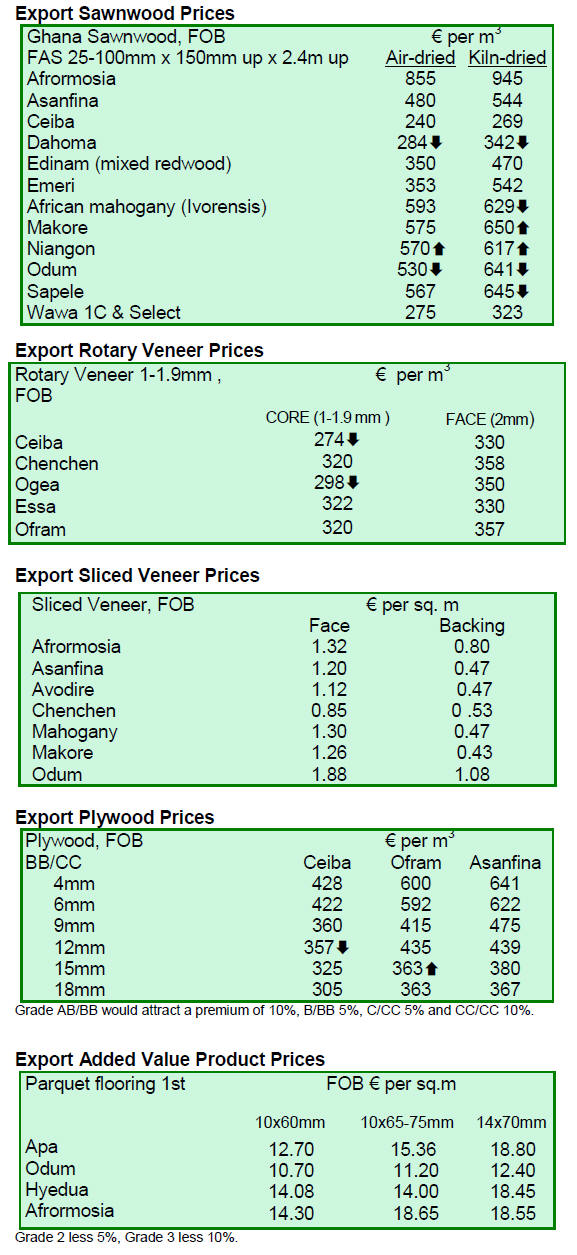
﹛
3. MALAYSIA
Glulam, another step forward
The MTC has signed a memorandum of understanding
with the Public Works Department (PWD) and an
architect, Ahmad Asmadi Architecture, to promote the use
of glulam in government funded projects in Malaysia.
Glulam, or glue laminated timber, is considered a versatile
timber construction material which is stronger than steel,
can be made fire resistant, is easy to machine and
assemble and most importantly, ecologically sustainable.
Structural glued-laminated timber is manufactured by
bonding assemblies of high-strength, kiln-dried lumber,
with waterproof adhesives.
The laminating process in glulam allows timber to be used
for much longer spans, heavier loads and more complex
shapes in construction, giving engineers and architects the
freedom to design a variety of shapes, from straight beams
to graceful, curved arches 每 without compromising on
structural or strength requirements.
Under the MoU, the PWD would provide engineering
design, including detailing and specifications to enhance
the capability to design glulam structures and monitor the
project. MTC plans to engage a suitably qualified
structural engineer to check, evaluate and verify the
engineering details prepared for the design of a glulam
surau (Muslim prayer house).
Certification not the saviour of the forest says head of
Sabah Forestry
In the recent international conference „Heart of Borneo‟s
Natural Capital: Unleashing their potential for sustainable
growth in Sabah‟, Sam Mannan, Director of Sabah
Forestry, made some interesting and strong points in his
speech.
Sabah is planning to increase its totally protected areas
from some 20% of the total land area to 30%, or from 1.35
million hectares today to about 2.10 million hectares over
the next 10 years.
Sabah will increasingly depend on planted forests
including commercial tree plantations as well as agoforestry
crops for timber supply and forest revenue.
Mannan made a strong point when he said: ※the world
could not care less about certified timber§ and ※this is our
experience, it is price that matters§.
He said certified timber is no longer a saviour. In today‟s‟
market it is pure economics and financial decisions that
drive people to buy or not buy certified timber.
Industry anticipates stronger business with India
The general manager of Sarawak Timber Industry
Development Corp (STIDC), Sarudu Hoklai, was reported
by the Star newspaper as saying Sarawak timber industry
will earn RM 7.8 billion from exports this year
(approximately US$ 2.4) as compared to RM 7.454 billion
last year. In 2011, total exports were RM 7.075 billion.
Meanwhile, WTK Holdings Bhd, a major timber group
based in Sibu, Sarawak expects Indian importers to
gradually increase their orders for Sarawak‟s tropical logs
now that the rupee is more stable compared to three
months ago. Some 73% of the group‟s logs exports went
to India in the third quarter of 2013.
※On a year-on-year basis, average round logs prices
increased by 5.1% while sales volume decreased by
25.8%,§ said WTK to The Star, adding that besides India,
the group exported round logs to Taiwan, China, Vietnam
and Singapore.
Some 80% of WTK‟s plywood exports went to Japan,
19% to Taiwan and the remaining 1% to China. As for the
group‟s plywood division, WTK said average selling price
rose by 8.9% but sales volume fell by 27.7% due to its
decision to reduce production of some non-premium
plywood products in anticipation of stock disposal by
other companies.
Plantation C&I open for public discussion
The Malaysian Timber Certification Council (MTCC) is
currently facilitating the second public discussion on the
review of the Malaysian Criteria and Indicators for Forest
Management Certification (Forest Plantations), referred to
in short as the M C&I (Forest Plantations). The Review
will be held throughout the month of December.
The M C&I (Forest Plantations) is the standard for
assessing the management practices for plantation forests
under the Malaysian Timber Certification Scheme
(MTCS) which has been implemented by MTCC since
2009.
MTCC has received no application to certify plantation
forests under this standard nevertheless the ongoing
review is in line with international practices that
certification standards be reviewed at least once every five
years to ensure continuous improvements.
The main body to undertake the review the MC&I (Forest
Plantations) and develop a revised standard will be the
Standards Review Committee (SRC).
This Committee will serve as the multi-stakeholder
※Forum§ and its members will comprise representatives
nominated by stakeholder groups representing the interests
of social, environmental and economic groups. Relevant
government agencies, from the three regions of Malaysia,
Sabah, Sarawak and Peninsular Malaysia will also
participate.
It is anticipated that the entire full review of the M C&I
(Forest Plantations) will be over by end of 2014.
Plywood price indications
Plywood traders in Sarawak have reported export prices as
follows:
Floor base B (11.5mm) US$ 680 每 685 FOB;
Fromboard (3 x 6 feet UCP)
Japan (3 x 6 feet UCP) US$ 530 每 550 FOB;
Middle East (9-18mm) US$ 460 FOB;
South Korea (8.5 每 17.5mm) US$ 480 每 500 C&F;
Taiwan (8.5 每 17.5mm) US$ 450 FOB;
China/Hong Kong US$ 460 每 480 FOB.
4. INDONESIA
Log exports from community forests
The Ministry of Forestry (MoF) has said exports of logs
from community forests will be permitted but that, for the
time being, exports of logs from industrial plantations
remain restricted. All exports of community forest
plantation logs must comply with Indonesia‟s timber
legality assurance system (SVLK).
The Secretary General of the MoF, Daryanto, said exports
of logs from community forests is unlikely to attract
international criticism as the move will benefit community
forest owners.
Daryanto also said the decision to allow plantation log
exports will encourage the expansion of community
owned plantations. At present most of the community
forests are in Java but hopefully the change in the law
allowing log exports will encourage the establishment of
plantations in other regions of the country.
The move to allow plantation log exports is expected to
result in a rise in plantation log prices.
Wood product exports may top US$5 billion
The Indonesia Ministry of Forestry (MoF) Director of
Processing and Marketing of Forest Products, Dwi
Sudharto, said that wood product exports in the first 10
months of this year are about 10% higher than in the same
period last year. The value of wood product exports from
January to October 2012 was US$4.2 bil. while in the first
ten months of 2013 the total was US$4.7 bil.
Some 64,682 V-legal certificates have been issued as of
November covering exports from 69 exit points in the
country.
The top five export destinations were China US$1.40 bil.,
Japan US$874.8 mil., South Korea US$378.2 mil., the
United States US$340.7 mil., and Australia US$194.0
mil.. Exports to Asian countries totalled more than 75% of
the total value of exports. Sawnwood exports to the
European Union at 346,000 tons ranked second after those
to Asian markets.
The main wood products exported were woodbased
panels, pulp, paper, wood crafts, and furniture. The
Executive Director of the Association of Indonesian Forest
Concessionaires. Purwadi Soeprihanto, said prospects for
Indonesian wood product exports are good now that the
timber legality assurance system in Indonesia has been
recognised by the European Union.
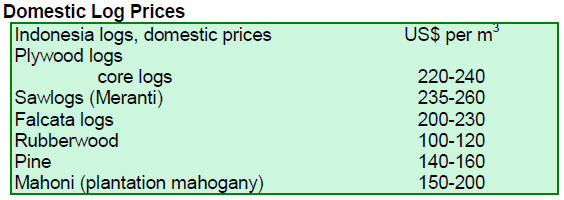
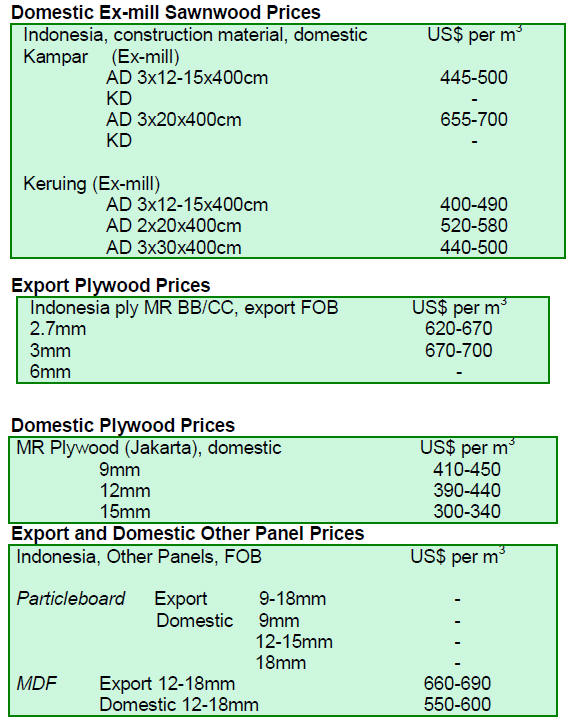
﹛
5. MYANMAR
Weak demand for non-teak hardwoods
Analysts report that the pace of teak log shipments
continues to increase driven by the impending log export
ban set to come into force in 2014.
Teak log prices have risen compared to levels observed in
October but, overall market sentiment is mixed. Demand
for non-teak hardwood logs remains weak. There has been
some interest in small purchases of Gurjan but, unlike the
demand for teak, it will need a miracle to drive up interest
in the non-teak hardwoods.
Investments from the EU
Myanmar President Thein Sein has urged European
companies to make responsible investments in Myanmar.
This was the theme of a meeting with representatives from
the EU in Naypyitaw in mid November. The President
said investment by EU companies would boost Myanmar‟s
economy and provide good returns for investors.
GSP and easing of financial restrictions a boost
private sector
According to the Irrawaddy Newspaper, the World Bank
has forecast that Myanmar‟s economy is set to grow 6.8 %
next year, placing it among Southeast Asia‟s fastest
growing economies. However, the Bank warns of the
impact of rising inflation on the poor.
The Bank review suggests economic expansion will be
driven by energy and commodities exports, foreign
investments, construction.
Foreign direct investment in Myanmar has so far risen to
US$2.7 bil. in fiscal 2012-13 up from US$1.9 bil. in 2011-
12. On the other hand the Asian development Bank (ADB)
is forecasting stronger growth supported by investor
optimism following policy reforms.
The reinstatement of Myanmar in the European Union‟s
Generalized System of Preferences for duty free and quota
free market access and the gradual easing of restrictions on
financial institutions are boosts to the private sector.
MTE announces log supply to domestic industry
The indications are that the Myanma Timber Enterprise
(MTE) will make available some 600,000 tons of
hardwood logs to the domestic industry in fiscal 2013-14.
In December this year the MTE plans to sell 430 tons of
teak logs to domestic millers.
This announcement was made by MOECAF Union
Minister Win Tun at the Amyotha Hluttaw (House of
Nationalities).
The MOECAF Minister, Win Tun, emphasized that the
decision to provide these raw materials to the domestic
mills was to stimulate job creation in the timber sector.
The Minister said that 186,650 tons of teak logs will be
extracted during this fiscal year which is 80,000 tons less
than last year. Similarly 787,600 tons of hardwood logs
will be extracted this year compared to the previous year‟s
1,355,227 tons.
November teak log tender results
The following shows the grade, quantity and prices for
teak logs during the 22 and 25 November tender
conducted by the MTE.
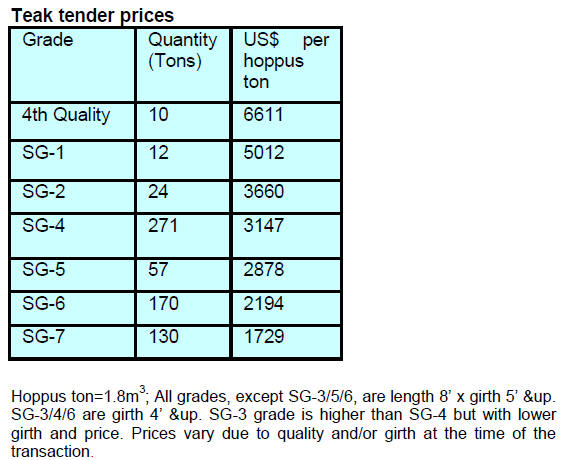
MTMA seeks clarification on commodity tax after
log
export ban
Under current system of sales the price of logs purchased
by domestic millers from the MTE are inclusive of the
commodity tax.
The Myanmar Timber Merchants‟ Association (MTMA) is
seeking clarification on how the commodity tax will be
levied after the 1 April 2014 entery into force of the log
export ban.
MTMA is also seeking exemption from the commodity tax
on logs purchased from MTE and those imported from
neighbouring countries saying this will improve the
competitiveness of the domestic industry and help
stimulate investment in the sector.
﹛
6.
INDIA
Manufacturers see positive signs in US
and EU
markets
The Indian rupee exchange rate has been steady over the
past weeks, moving in a narrow range of 62-63 to the US
dollar. Exporters have benefited from the weaker rupee
and export values have grown at the fastest pace for two
years.
Export shipments rose by 13.5% to US$27.3 billion in
October while imports of gold and silver dropped
precipitously by 80% which has helped narrow the trade
deficit to around US$10.5 billion, nearly half the level
seen a year ago.
Factory output is said to be improving and figures for
October show a 2% gain in output over the figures for
September. Manufacturers see positive signs of improved
demand in the US and Europe markets.
Plywood industries struggle with competition from
reconstituted panels
The woodbased panel sector is still suffering from
shortages of raw materials which is pushing up prices for
logs, chemicals and fuel. Labour shortages are now
increasingly of concern.
To add to the woes of the plywood industry, re-constituted
boards such as MDF, HDF, WPC (wood plastic
combination) boards and particleboards are increasingly
replacing plywood.
Rising costs and competition with substitutes are eating up
profitability in the plywood sector. Competition in the
woodbased panel sector is shifting in favour of the
composite boards as prices are very competitive and the
quality of the panels now available is so much better than
in the past because of improved manufacturing
technologies.
The reconstituted panel manufacturers have moved
downstream and are now laminating panels within their
own plants thus cutting out intermediary companies which
previously handled the lamination. These boards from the
panel mills now go directly to manufacturers of furniture,
doors etc.
These changes are bringing very competitively priced
products to the consumer. Recently the Ministry of Public
Works and the Military Engineering Services have
permitted the use of reconstituted boards in public sector
works thus reducing the share of plywood in this market
segment.
Laminated boards have also affected consumption of solid
wood for doors. In India today flush doors are becoming
more popular in up-market homes.
Currently there are around 85 plants producing veneered
flush doors, laminated flush doors and moulded flush
doors with PVC membranes. Because Indian carpenters
find wages better in the Gulf States Indian producers of
solid doors are having to increase wages to keep
carpenters but this means there products become more
expensive and they find themselves priced out of the
market.
India has introduced an employment scheme under which
a worker when employed must be guaranteed at least 100
days employment. This has reduced labour mobility and
caused a scarcity of workers. The scheme applies to unskilled
and skilled workers.
This welfare measure introduced by the state is a problem
for plywood mills which are more labour intensive than
the sophisticated reconstituted board factories.
Because of labour shortages many plywood mills have had
to limit production to one shift.
Imports now dominated by hardwoods other than teak
With the conclusion of the Hindu New Year holidays the
timber markets have come back to life and stocks have
started to move once more. Currently, demand is stronger
in the smaller towns and moffusil areas rather than in the
metropolitan areas.
Analysis of species imports shows that non-teak tropical
hardwood imports continue to gain over teak and analysts
point to several reasons for this. The first reason is that
good quality plantation teak from Africa is getting scarcer;
secondly, Myanmar teak is getting more and more
expensive.
African teak can be landed in India at between Rs.1200 每
1500 per cubic foot and Myanmar teak is priced between
Rs.2000 每 2700 per cubic foot. In contrast Malaysian
species are available in the range of Rs.700~900 per cubic
foot.
Current C & F prices for imported plantation teak,
Indian
ports per cubic metre are shown below.

Domestic ex-sawmill prices for air dried
sawnwood cut
from imported logs
Demand is steadily improving as these are most
economically available good timbers for construction as
also industrial uses.
Prices for air dry sawnwood per cubic Foot,
ex-sawmill
are shown below.
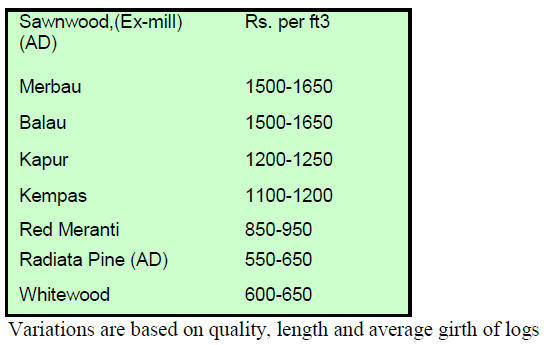
Domestic prices for Myanmar teak processed in
India
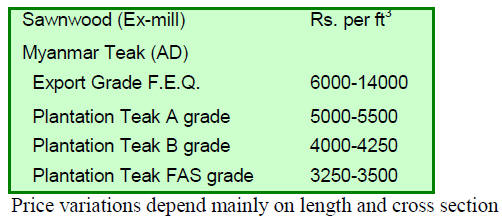
Prices for imported sawnwood
The recent slowing in the Indian economy and the weak
housing market is still capping prices for imported
sawnwood. Ex-warehouse prices for imported kiln dry
(12% mc.) sawnwood per cu.ft are shown below.

Plywood Market trends
Due to poor market conditions prevailing in the housing
and furniture sectors, prices have remained steady. Many
small scale plywood mills in South India are facing
licensing problems and will not be operating until this
situation is resolved.

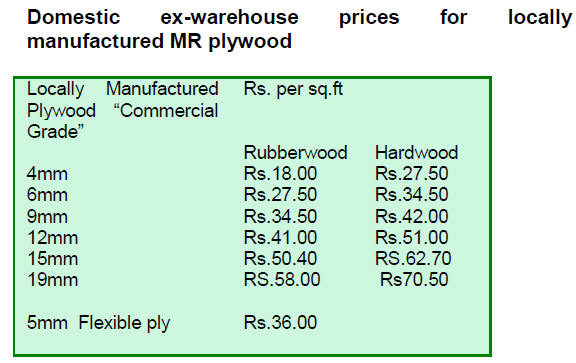
7.
BRAZIL
Base rate increase
Brazil‟s Consumer Price Index (IPCA) rose from 0.35% in
September 2013 to 0.57% in October 2013 bringing the
accumulated IPCA for the year to October to 4.38%. This
is the same level as recorded for all of 2012.
Over the twelve months from November 2012 the index
stood at 5.84%, marginally below the 5.86% registered in
the previous twelve months.
At its end November meeting the Central Bank Monetary
Policy Committee (Copom) increased the base interest rate
to 10% a half percent an increase of 0.5% on the rate set at
the last meeting.
Even companies operating with approved management
plans face huge hurdles
Brazilian tropical sawnwood production is concentrated in
the states in the Amazon Region. Domestic producers,
generally source logs from areas with sustainable
management plans, from other concessions and from
public forests such as National Forests (FLONAS 每
Florestas Nacionais) and/or State Forests (FLOTAS -
Florestas Estaduais). Some companies purchases logs on
the open market.
The recently released 2013 Sectoral Study from the
Brazilian Association for Mechanically Processed Timber
Industry (ABIMCI) suggests that, the intense control of
logging operations by environmental agencies and the
overwhelming burden of bureaucratic red tape has become
a significant hurdle even to companies operating with
approved management plans.
The combined impact of these problems and other factors
such as seasonal weather changes, taxation issues and poor
infrastructure has been a sharp reduction in the supply of
logs from natural forests. This reduced supply has caused
prices to rise to a level where tropical log raw materials
are becoming uncompetitive.
It has been observed, says the ABIMCI report, that the
supply of logs from legal sources has dropped
considerably.
By way of example, the report says in the state of Par芍,
one of the leading states having tropical forests in Brazil,
only about 324,000 cu.m of tropical sawnwood was
harvested in 2011 and in 2012 the volume harvested fell to
305,000 cu.m in 2012 (-6%).
By way of contrast, mills in the state produced around
390,000 cu.m of sawnwood representative of a log input of
around 5-600,000 cu.m.
In 2012, production of tropical sawnwood in Brazil
totalled around 6.0 million cu.m, a 57% decline from
levels in 2000. In the period 2000 - 2012, between 88%
and 94% of domestic tropical sawnwood production in
Brazil was consumed by the domestic market.
African mahogany - a new plantation investment
option
It has been found that the soil and climatic conditions in
the state of Mato Grosso, one of the main tropical timber
producing states in the Amazon region, are suitable for
growing African mahogany. The plantation area in Mato
Grosso is expanding as private companies invest to secure
raw materials.
In October a technical guideline on the commercial
establishment of African mahogany was launched. This
technical guideline was drafted with support from the
State Government, through the Secretariat for Rural
Development and Family Agriculture (Sedraf) and the
Mato Grosso agency for Research, Rural Assistance and
Extension (Empaer). Support was also provided by the
Center for Timber Producers and Exporters Industries of
Mato Grosso (Cipem).
The Bank of Brazil is encouraging this development as it
wishes to finance plantation projects which it considers a
new option for investment by both the timber sector and
farmers.
According to Empaer, the establishment of African
mahogany plantations could become a significant
investment for farmers and the timber industry as a high
value timber will be produced. Through the introduction of
African mahogany the state of Mato Grosso aims to bring
unproductive deforested and degraded land back into
productive use.
October trade trends
In October 2013, the value of wood products exports
(except pulp and paper) increased 15% over levels in
October 2012, rising from US$198.1 million to US$ 228.4
million.
Pine sawnwood exports increased 21% in value in October
2013 compared to October 2012, from US$13.1 million to
US$15.8 million. In terms of volume, exports rose 12.6%,
from 60,500 cu.m to 68,100 cu.m over the same period.
In October this year tropical sawnwood exports fell 15%
in volume, from 32,200 cu.m (October 2012) to 27,400
cu.m.
The value of these exports fell by only 1.9% from
US$16.1 million to US$ 15.8 million over the same
period.
In contrast, pine plywood exports grew 37% in value in
October 2013 compared to October 2012, from US$27.5
million to US$37.7 million. The volume of exports
increased 46.4% from 74,500 cu.m to 109,100 cu.m.
during the same period.
While pine plywood exports have been performing well,
tropical plywood exports fell 25.4% in October from 5,900
cu.m in October 2012 to 4,400 cu.m in October 2013. In
value terms exports of tropical plywood fell 23%, from
US$3.5 million in October 2012 to US$2.7 million in
October 2013.
Exports of wooden furniture increased from US$ 41.9
million in October 2012 to US$ 44.3 million in October
2013, a 5.7% increase.
Falling production undermines regional growth
The sectoral study published by ABIMCI illustrates the
declining trend in Brazilian exports of tropical sawnwood
in the period 2000-2012.
In terms of volume between 2000 and 2012 there was a
66% decline, (av. 8.5% per year) in tropical sawnwood
exports. In the same period the value of exports dropped
37%.
Annual tropical sawnwood exports grew up until 2004,
and then gradually began to decline, a trend which
continues today. In the 2007 - 2008 period, there was a
sharp decline in tropical sawnwood exports as trade was
affected by the global economic crisis.
Analysis of export data for 2011 and 2012 reveals that the
downward trend continued and had a strong negative
impact on development in the production areas.
The slowdown in tropical sawnwood production had a
strong impact, not only on the sector itself, but also on
industrial production, job security, tax incomes socioeconomic
development. The report also suggests that the
decline in tropical sawnwood production and export has
affected the value placed on forest assets.
In 2008, the largest exporters of tropical sawnwood were
located in the state of Par芍 (with 49%) and in the State of
Mato Grosso (22%). In 2012, despite the reduction in the
value of exports in relation to 2008, the state of Par芍
remains the largest exporter of tropical sawnwood
accounting for 43% of the national total export. The state
of Rondônia accounted for 10% of 2012 tropical
sawnwood exports.
Furniture and wood sector discuss exports to Italy
Possibilities of timber and furniture export to Italy, were
discussed between the timber and furniture industry
associations in Acre State (Sindusmad and Sindm車veis)
and the Federation of Industries in the State (FIEAC). The
focus of the discussions were on what innovations and
process improvements would be required to produce
products suitable for the Italian market.
Representatives from the National Service for Industrial
Learning (SENAI) and the Brazilian Amazonia
Association (Associazone Amazzonia Brasile), which
currently provides the link between Acre state and Italian
companies, participated in the meeting.
The Brazilian Amazonia Association reported that Italian
furniture companies have shown an interest in importing
quality certified products from Acre. According to
Sindusmad, one of the biggest obstacles reported by
entrepreneurs is the high tax burden on the timber
industry. Another barrier is that in Acre state most
companies are small-sized and would find it difficult to
satisfy large export orders.
One of the first steps recommended to allow exporters
from Acre to be better known would be participation in the
1014 Milan Furniture Fair and the World furniture
Exhibition in 2015.
Price trends
The average price of timber products in BRL did not show
variation from the previous fortnight.
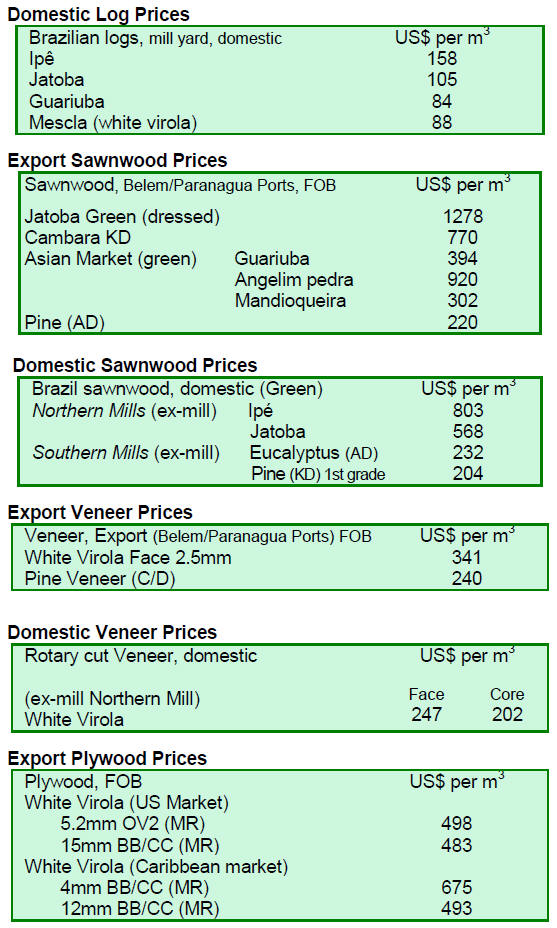
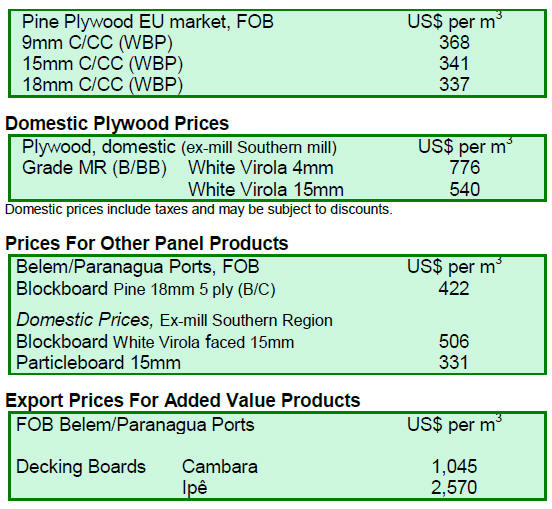
8. PERU
Deforestation in Cusco
According to a study conducted by the regional
government, deforestation in Cusco continues at an
alarming rate. The study suggests that over 70,000 ha. of
forest are being lost every year.
Edwin Mansilla, the Deputy Director in the Natural
Resources Department, attributed the losses to illegal
logging, illegal mining and the increased incidence of
forest fires.
The highest rate of deforestation was observed in
Quispicanchi, bordering Madre de Dios. Quispicanchi
Province is one of thirteen provinces in the Cusco Region
in the southern highlands of Peru.
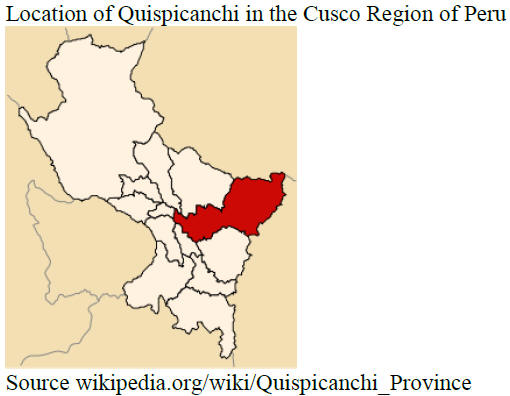
Ninoska Rozas, a manager in the Natural Resources
Department, said that forest loss was putting many native
forest species at risk of extinction. Cusco still possesses
significant biodiversity and some 40% of the region is
considered as Amazonian. To date some 177 key
biodiversity areas have been identified mostly in the
province of La Convencion.
US$300 million to mitigate climate change
The environment ministry (Minam) reported that US$300
million of international cooperation projects would be
implemented in the country to mitigate the effects of
climate change. Deputy Minister, Strategic Development
of Natural Resources, Gabriel Quijandr赤a, has indicated
that projects would be undertaken that go beyond the
issues of adaptation and mitigation of climate change.
He said "The mitigation issues are important to reduce the
damage caused by climate change but that it is also
important to improve forest management in the country so
that Peru ceases to be a contributor to the climate change
through deforestation§.
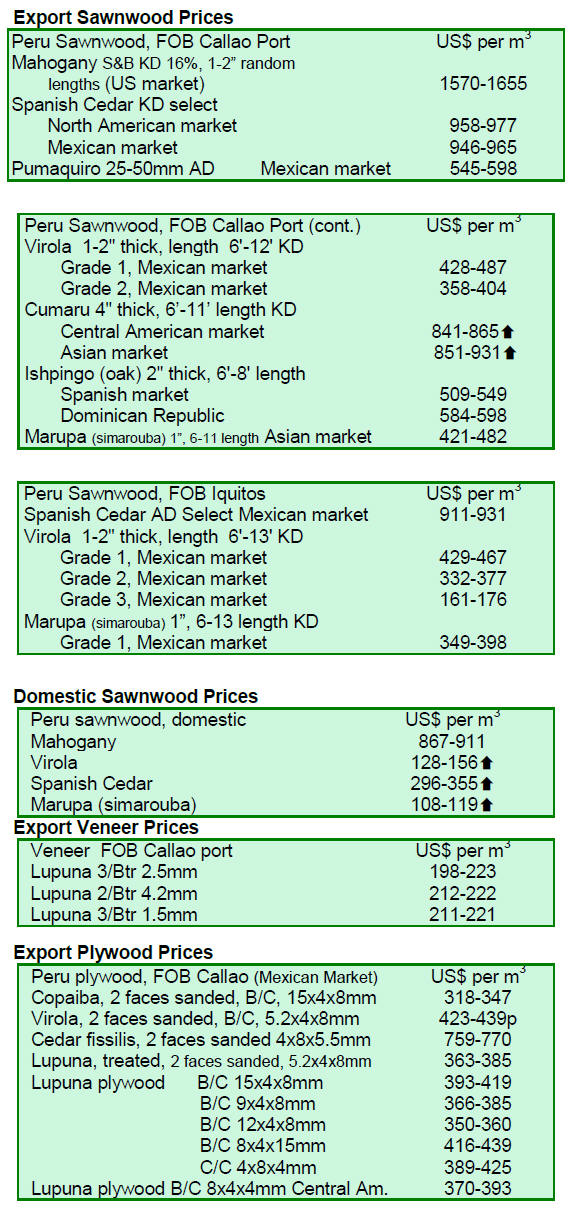

9.
GUYANA
Purpleheart prices beat expectations
Active price movements for purpleheart logs were seen
during the period reviewed. Purpleheart logs and
sawnwood attracted significantly improved prices in
contracts concluded over recent weeks.
Purpleheart Standard sawmill quality logs earned top end
prices of US$355 per cubic metre FOB significantly up
on the price of US$235 seen last month.
Improved prices were also achieved for Fair sawmill
quality purpleheart logs where the best price was US$280
per cubic metre FOB.
For Small sawmill quality purpleheart logs FOB prices
were in the region of US$250 per cubic metre. The
principal export market for recent shipments of
purpleheart logs was India.
Demand for sawnwood firms lifting prices
Sawnwood FOB prices improved in the period under
review. Undressed sawn greenheart attracted good prices
for Select category and top end FOB prices moved from
US$954 to US$1,484 per cubic metre.
Sound category Undressed sawn greenheart price moved
from US$741 to US$804 per cubic metre FOB and the
improved momentum in prices spilled over to
Merchantable quality Undressed sawn greenheart where
FOB prices moved up from US$594 to US$721 per cubic
metre.
The leading markets for Undressed Greenheart timber
species include the Caribbean, Europe, Middle East and
North America.
Undressed Purpleheart sawnwood prices benefited from
the overall firm demand and FOB prices for Prime
category timbers increased from US$1,080 to US$1,200.
This price increase was mirrored by prices for Select
category purpleheart sawnwood where FOB prices firmed
from US$1,993 to US$2,250 per cubic metre. For
Merchantable quality the price increase went from
US$640 to US$827 per cubic metre FOB.
One endues for mora is railway sleepers and sales of sawn
mora for sleeper category earned favourable prices of as
much as US$749 per cubic metre in the Caribbean market.
Additionally Dressed Greenheart maintained firm prices
on the export market (US$ 1,102 per cubic metre) during
this period in comparison to the previous period. The main
market was the Caribbean.
Dressed purpleheart attracted high prices on the export
market, there was price activity in the prime category
earning as much as US$ 1,550 per cubic metre attracting
the market of New Zealand.
However, in the standard category top end prices fell
during this period from US$ 1,230 to US$ 1,060 per cubic
metre.
There was no export of Plywood during the period
reviewed.
Splitwood managed to secure noteworthy prices as much
as US$ 1,300 per cubic metre on the export market
attracting the destination of the Caribbean, Middle East
and North America. Roundwood (Piles and Posts)
exported during this period made it way on to the
Caribbean and North American market.
Greenheart Piles earned fair pricing as much as US$ 563
per cubic metre, while Wallaba Post made an input of US$
663 per cubic metre.
Value added products also made a valuable contribution
towards the total export earnings during this period. Many
of Guyana‟s commercialised species were used to craft
and produce these items into beautiful value added
products.
Update on Guyana*s EU FLEGT VPA process
Stakeholder involvement in the EU FLEGT VPA Process
is a critical component and as such efforts are continually
being made to reach all stakeholders. In this regard, work
on the communication and consultation strategy and the
scoping of impacts has begun and should be completed by
year end.
In addition, the stakeholders awareness sessions arel
ongoing with focus on creating awareness and providing
updates on the FLEGT VPA process to stakeholders
across the country.
Additionally, the scoping of impacts study has
commenced with the aim of identifying the potential
impacts of the VPA be and how these will vary for
different stakeholder groups.
Work is still ongoing on Guyana‟s legality assurance
system with emphasis on the legality definition. Feedback
on this draft document is currently being sought from
stakeholders and is available on Guyana Forestry
Commission‟s website.

﹛
